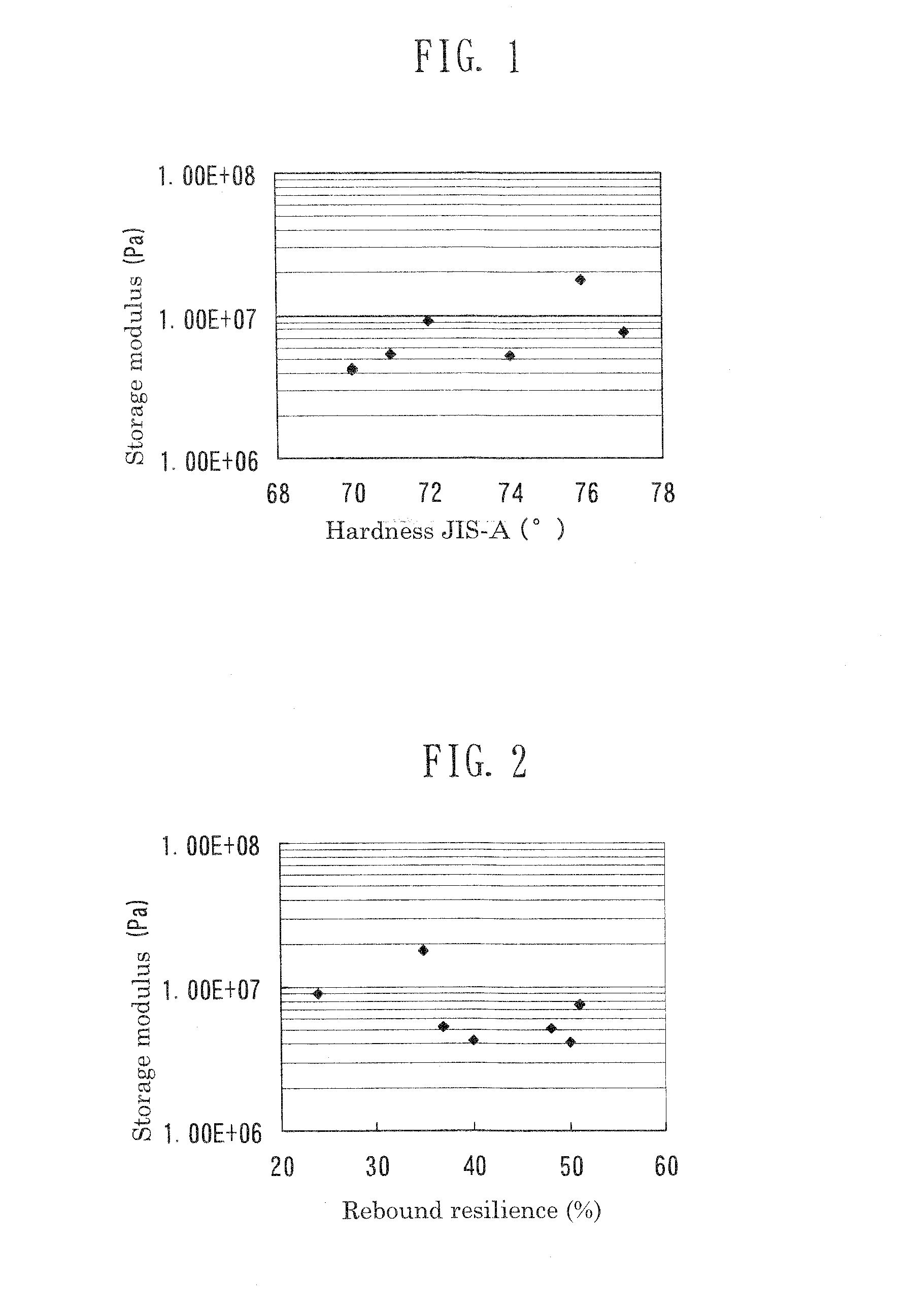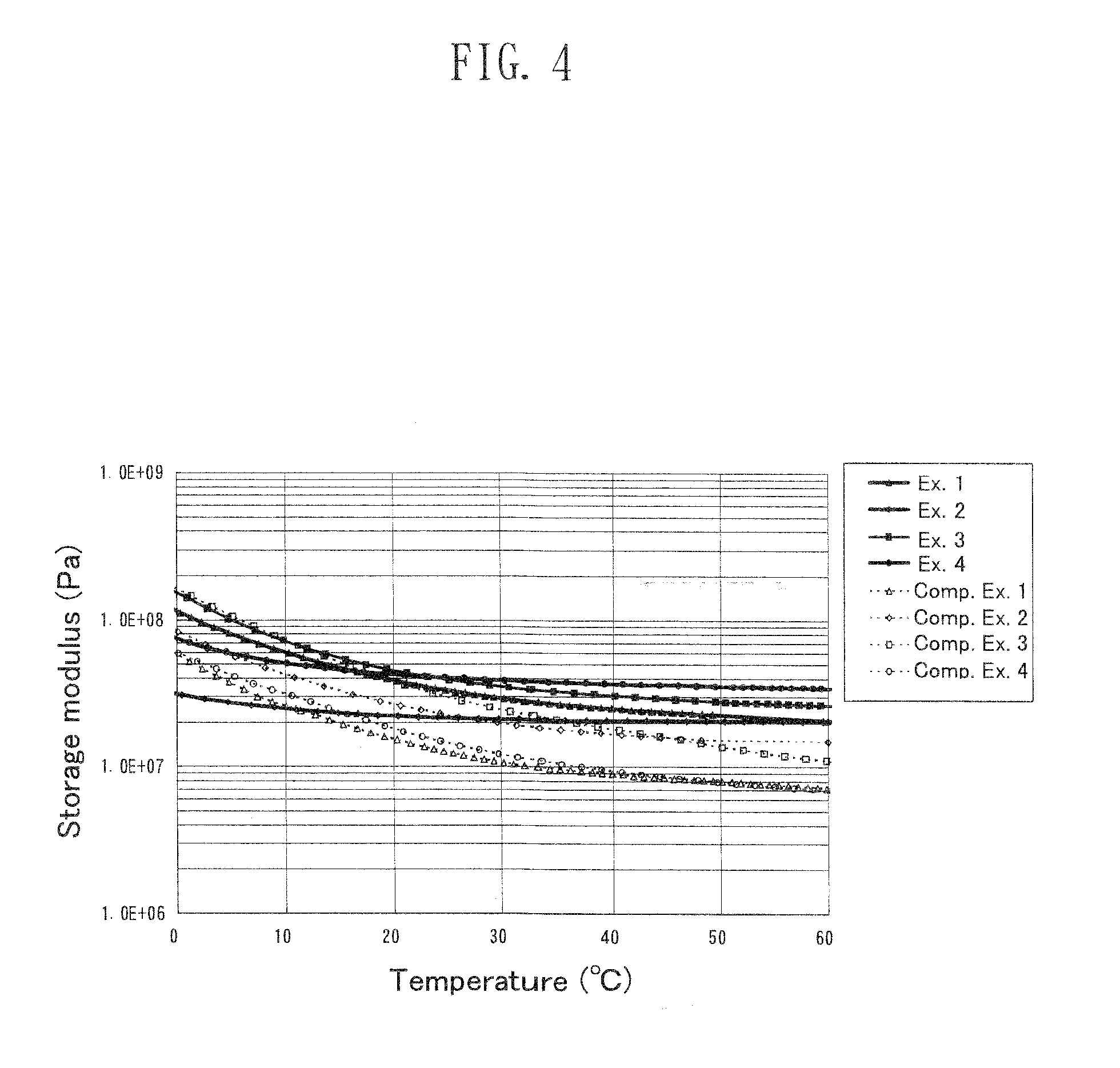Blade member
- Summary
- Abstract
- Description
- Claims
- Application Information
AI Technical Summary
Benefits of technology
Problems solved by technology
Method used
Image
Examples
example
Example 1
[0047]A polyester diol having a molecular weight of 2,000 was produced from adipic acid and a mixture of 1,9-nonanediol. (ND) and 2-methyl-1,8-octanediol (MOD). The polyester diol (100 parts by mass) and 4,4′-diphenylmethane diisocyanate (MDI) (50 parts by mass) were mixed to give a prepolymer. To the prepolymer maintained at a predetermined temperature, 1,3-propanediol (PD) and trimethylolethane (TME) were added in such amounts that the α value and K value were adjusted to 0.95 and 4.0, respectively, and the tri-functional content (mole ratio) of the cross-linking agent was adjusted to 0.3. Mica (8.5 parts by mass) was further added to the mixture. The resultant mixture was allowed to react at a predetermined temperature for curing, to thereby form a polyurethane sheet. The polyurethane sheet was cut to give test samples of Example 1 and cleaning blade members of Example 1 having a thickness of 2.0 mm.
[0048]In each test sample, mica was present in a ≧5% area of a cross-se...
example 2
[0049]Polyoxytetramethylene ether glycol (PTMG) having a molecular weight of 1,400 (100 parts by mass) and 4,4′-diphenylmethane diisocyanate (MDI) (60 parts by mass) were mixed to give a prepolymer. To the prepolymer maintained at a predetermined temperature, 1,4-butanediol (1,4-BD) and trimethylolpropane (TMP) were added in such amounts that the α value and K value were adjusted to 0.95 and 3.4, respectively, and the tri-functional content (mole ratio) of the cross-linking agent was adjusted to 0.2. The resultant mixture was allowed to react at a predetermined temperature for curing, to thereby form a polyurethane sheet. The polyurethane sheet was cut to give test samples and cleaning blade members of Example 2.
example 3
[0050]A prepolymer was produced from a polyol (molecular weight: 1,000) (60 parts by mass) produced from adipic acid and a mixture of 1,9-nonanediol (ND) and 2-methyl-1,8-octanediol (MOD); a polyol (molecular weight: 2,000) (40 parts by mass) produced from adipic acid and a mixture of 1,9-nonanediol (ND) and 2-methyl-1,8-octanediol (MOD); and 1,5-naphthalene diisocyanate (NDI) (40 parts by mass). To the prepolymer maintained at a predetermined temperature, 1,4-butanediol (1,4-BD) and trimethylolpropane (TMP) were added in such amounts that the α value and K value were adjusted to 0.95 and 2.4, respectively, and the tri-functional content (mole ratio) of the cross-linking agent was adjusted to 0.5. The resultant mixture was allowed to react at a temperature 20° C. lower than that employed in Example 1, to thereby form a polyurethane sheet. The polyurethane sheet was cut to give test samples and cleaning blade members of Example 3.
[0051]The polyurethane sheet was observed under a micr...
PUM
| Property | Measurement | Unit |
|---|---|---|
| Temperature | aaaaa | aaaaa |
| Temperature | aaaaa | aaaaa |
| Temperature | aaaaa | aaaaa |
Abstract
Description
Claims
Application Information
 Login to View More
Login to View More - Generate Ideas
- Intellectual Property
- Life Sciences
- Materials
- Tech Scout
- Unparalleled Data Quality
- Higher Quality Content
- 60% Fewer Hallucinations
Browse by: Latest US Patents, China's latest patents, Technical Efficacy Thesaurus, Application Domain, Technology Topic, Popular Technical Reports.
© 2025 PatSnap. All rights reserved.Legal|Privacy policy|Modern Slavery Act Transparency Statement|Sitemap|About US| Contact US: help@patsnap.com



